
- Free Article: No
- Contents Category: Fiction
- Review Article: Yes
- Online Only: No
- Custom Highlight Text:
It is a mark perhaps of her publisher’s confidence and her own bestselling status that the cover of Alice Pung’s second book has her name in large print, dwarfing even the title itself. Her Father’s Daughter is the sequel to Pung’s Unpolished Gem (2006), and the memoir picks up a couple of years later with the author having dusted away adolescence and now being in the midst of the equally bewildering twenty-something years.
- Book 1 Title: Her Father’s Daughter
- Book 1 Biblio: Black Inc., $29.95 pb, 244 pp
Echoing the first sentence of Unpolished Gem (which deliberately sets itself apart from other migrant literature by not beginning on a boat), Pung rather self-consciously sets her early scenes on a bus to Chaozhou, China; she is on her way to visit her grandparents’ ancestral home. Previously, she had been in Beijing on a three-month artist residency, hoping to capture any authentic feeling of homeland, but failing to connect with the heavily industrialised and alien landscape. Beginning with this pilgrimage to search for the roots of her identity, Pung moves back and forth in time and place, unearthing memories along the way that had otherwise lain dormant.
Although the book can be read as a discrete work, it functions better as a companion piece to Unpolished Gem. While Pung had earlier intimated how Pol Pot’s genocidal regime precipitated her family’s migration to Australia, here she expands on the story. Hence, Her Father’s Daughter is stained with a much darker hue, one unleavened by the anecdotal humour sprinkled throughout Unpolished Gem. Pung also extends her geographical reach beyond Melbourne’s western suburbs, with the narrative shifting between China, Australia, and Cambodia. However, differences aside, this book is just as much about familial ties and strictures; cultural obeisance versus individual freedom. Most pointedly, it also explores attempts to desensitise the past by affecting a wry nonchalance when it comes to painful episodes. While her father had a small role in her first book (the stage was dominated by Pung and her warring mother and grandmother), here he shares equal billing with the author. Written in lucid and affecting prose, Her Father’s Daughter is ultimately a filial love song that carries with it the notes of acceptance and understanding.
On the surface, the Chinese-Cambodian Pung family represents the epitome of the migrant success story. After years of drudgery, they successfully open an electronic appliance franchise store, and prudently amass financial security, a double-storey house, and a smattering of investment properties. The second generation is raised to be conscientious, high-achieving exemplars worthy of their parents’ sacrifices. Like millions of refugees before them, the Pungs struggle not to be moulded or condemned by their past, even if that entails a goldfish memory in order to survive.
That one can never fully escape one’s history is intrinsic to the book’s thematic explorations. The horrors witnessed firsthand in the Year Zero killing fields has the effect, decades later, of her father wanting to sequester his family within rigorously controlled boundaries where he can keep a benevolent eye on them. Pung writes movingly of her parents’ tightly coiled lives, of ‘the little yellow nuclear family ensconced inside the large white house, like an egg inside an eggshell’. As a daughter and the first-born child, she is clutched to the parental bosom with a love that is obsessively claustrophobic. After four years enveloped in the sighs of the sick, tortured, and dying, Pung’s father can allow his beloved daughter to succumb to nothing more injurious than a paper cut. His paranoia about personal safety translates into early curfews for his adult children, expecting the worst outcome every time someone steps out the front door, and even filing back the pointy end of a large kitchen knife to prevent inadvertent nicks.
The narrative, written in the third person, alternates between daughter and father, as if they are having a conversation; each trying to make the other understand a different generational and cultural perspective. As a sequel of sorts, the memoir continues sketching the portrait of the artist as a young woman – leaving home and finding a place of her own, employment as an articled law clerk and as a university tutor, and adventures in love and travel – but the book really hits its stride when it details the long, hard years of survival in a labour camp under the Black Bandits’ rule in Cambodia. Pung takes on the role of the ventriloquist, allowing the experiences of her father to bleed through the page, and the stories he tells are harrowing. Starvation led him to boil his belt and feed it to his family in small pieces. Compelled to become the camp gravedigger, he was never short of work. The real miracle, Pung muses, is not that he survived the Khmer Rouge, but that he was still capable of love.
Before arriving in Australia, her father had ‘done a spring clean of his mind, brought a truck in there to haul out all the debris’. In Her Father’s Daughter, Alice Pung has raked through the blunted shards of his memories to reconstruct his story of loss, survival, and love.


Comments powered by CComment